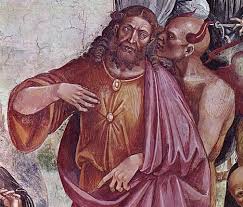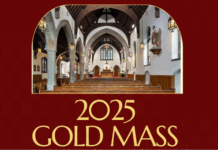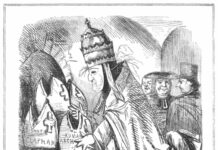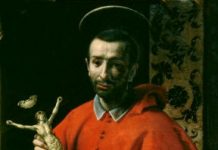Jesus Christ the righteous…he is the atoning sacrifice for our sins, and not for ours only but also for the sins of the whole world (1 Jn. 2:1-2).
The Easter Season is a privileged time of liturgical catechesis called mystagogy because it draws into the Mystery of Christ, a reality that is the foundation of our hope and the reality that illuminates our entire earthly pilgrimage, including the enigma of suffering and death (Pope Benedict XVI). This is the Mystery that we celebrate with great care and solemnity every year, the Paschal Mystery; and this Mystery is the source of our renewal and of our life in Christ. As the word mystery is used in the New Testament, it signifies an object of revelation. In other words, it is not something that we could come to know without God revealing it. St Peter’s sermon quoted in our First Reading speaks of this mystery as foretold though all the prophets (Acts 3:17), though evidently misunderstood and even rejected. The Mystery of course, is Christ Our Lord and the content of this Mystery is summarised for us by the Apostle John in our Second Reading: Jesus Christ the righteous…he is the atoning sacrifice for our sins, and not for our sins only but also for the sins of the whole world (1 Jn. 2:1-2).
The word that Saint John uses to describe the sacrifice of our Lord is atoning. Atonement is a concept which explains how Our Lord achieved our salvation and it is absolutely essential to have an understanding of this concept if we wish to understand our Christian faith. The expiation of our sins and our reconciliation with God is atonement, namely at-one-ment or bringing together. In Himself Christ Our Lord brings together divinity and humanity and what had been lost through the devil’s deception is restored by Our Lord’s atoning sacrifice. An ancient Easter homily (attributed to St. John Chrysostom) speaks of the Paschal Mystery in a manner that may help us to understand how to make this Mystery our very own and grow in its knowledge and power. Christ, the sacrifice that was offered for us, is the father of the world to come. He puts an end to our former life, and through the regenerating waters of baptism in which we imitate his death and resurrection, he gives us the beginning of a new life. The knowledge that Christ is the Passover lamb who was sacrificed for us should make us regard the moment of his immolation as the beginning of our lives. As far as we are concerned, Christ’s immolation on our behalf takes place when we become aware of this grace and understand the life conferred on us by this sacrifice (The Liturgy of the Hours, p. 645).
It could be said that this is what took place in the hearts and minds of our Lord’s disciples when our Lord appeared to them, as our Gospel text relates. ‘These are my words that I spoke to you while I was still with you – that everything written about me in the Law of Moses, the Prophets, and the Psalms must be fulfilled.’ Then he opened their minds to understand the Scriptures…. You are witnesses of these things (Lk. 24:44-48). We know that once the disciples came to the awareness of these truths, everything literally changed. They boldly proclaimed the truth of the resurrection and this has continued through the ages; and we in our day are now the witnesses of these things. The truth of the Resurrection is not true because we believe it to be true; it is true in itself. However, the power of its truth is only felt when we become aware of its implication in our own lives. Surely, each year that we celebrate the Paschal Mystery we do become more aware of this grace; and understand with greater depth of understanding the life conferred on us by Our Lord’s sacrifice. This is instruction and growth in the Mystery of Christ, mystagogy; and because our lives change and we change and grow, this truth must be brought to bear on the concrete circumstances of our lives here and now. We approach these Feasts each year with a sense of expectation and hope in the awareness that God desires that we come to a deeper awareness of the life that is ours because of our Lord’s saving Sacrifice. This is what active participation in the Sacred Liturgy implies: a deeper sense of the truths and events of salvation and their effect on our life.
In the Paschal Mystery, the words of Scripture are fulfilled; and this means that the atoning sacrifice of Our Lord ‘according to the Scriptures’ is an event that bears within itself a ‘logos’ a logic (Pope Benedict XVI, Easter Wednesday Catechesis, 2009). This is the only logic capable of explaining the entire history of man and of the world. On a more intimately personal level, the Paschal Mystery enables us to understand our own existence. To enter into this Mystery and to strive to understand the events of our own lives by its meaning and logic is what Our Lord calls each one of us to do and what the Sacred Liturgy endeavours to do during this privileged time of instruction. Our prayerful presence here on this the Lord’s Day, the dies Domini that each week celebrates the Resurrection is our encounter with the Risen Lord. Our hearts do burn with love when Our Lord speaks to us in the Gospel that is proclaimed and like the disciples on the road to Emmaus, Our Lord is made known to us in the breaking of the bread (Lk. 24:35).
The fullest expression of the Paschal Mystery is the celebration of the Holy Sacrifice of the Mass and the devout reception of Holy Communion. In the Sacrifice of the Mass, our Lord’s Atoning Sacrifice is made present on our Altar and in the Sacrament of Holy Communion, we the many are brought together and made one in Christ and we are reconciled to God who created us to share in the incorruptible glory of the resurrection (Prayer after Communion, Third Sunday of Easter, The Roman Missal). So we pattern our lives on the Mystery that we profess and that we celebrate and this is the lesson and the work of a lifetime.
As we face another lockdown and the suspension of the public celebration of the Holy Sacrifice of the Mass, we do well to resolve to be attentive to this liturgical season by being especially attentive to the instruction that the sacred liturgy provides. As you may well know, a prominent Catholic figure in the United States has recently called for the eradication of the Traditional Liturgy and if you can believe it, the prohibition of the presence of children and young people at such celebrations. This sounds terribly communist but when one considers the specifics of this revolutionary call to action, there is something even more sinister at work. In my studied opinion, it is not an accident that the publication of what amounts to a manifesto coincides with the announcement of an upcoming international theological symposium on a fundamental theology of the priesthood (Rome, Feb. 17-19, 2022). For over fifty years there has been an effort to deny both the sacrificial nature of the Mass and of the priesthood by consequence. The eclipse of the Mass as a Sacrifice has led to the eclipse of the Christian Faith, of the Christian life and by consequence, of the Christian light in the world. It is not an exaggeration to say that we are now involved in an epic battle with the forces of the antichrist, the antichurch and the anti-gospel. Dom Prosper Gueranger observed: If the Holy Sacrifice of the Mass should come to an end, it will not take long for us to fall back into the abyss of depravity where the pagans once were, and this would be the work of the antichrist.
And it is also no exaggeration to say that we now find ourselves in this abyss of depravity where the pagans once were. Nevertheless, the fact that a significant number of younger people and young families with their children are attending the Traditional Mass and seeking out parishes that promote reverence for the sacred should encourage us to take on this fight with every possible arm at our disposal. If a plan of action may be mapped out even as we face new restrictions, there are two things that we can all do:
Hold fast to orthodox doctrinal definitions and external practices and be attentive to the liturgical seasons. There is no better plan of action in regard to our spiritual life than the rhythm and flow of the liturgical year. The Mystery of Christ unfolds for us each and every year, culminating with the celebration of Easter. A Traditional Missal is a sure guide and aid in helping us to be attentive to the liturgical seasons. Make every effort to live for Sunday.
Lastly, let us note that modernists have a visceral hatred for the sacred. This explains why the revolutionaries who have already done so much damage to Catholic life will not cease their destructive work even as the spectre of death looms over them. They seem incapable of recognising a causal connection between their revolutionary violence and the decline of the Church. This is proof positive that sin does indeed cloud the intellect. The circumstances of our times are such that we are all faced with a choice to make: authentic Catholic life on the one hand, or something vaguely comfortable but ultimately meaningless, purposeless and most horrifying of all, damnable. As far as we are concerned, Christ’s immolation on our behalf takes place when we become aware of this grace and understand the life conferred on us by this sacrifice. We are indeed aware of this grace and we desire no other life for apart from our Saviour there is only death and destruction. Non praevalebunt! The modernists will not prevail. Let us [then] consider how we may spur one another on toward love and good deeds, not giving up meeting together … but encouraging one another (Heb. 10:24-25). In the certainty of this truth, we undertake all our efforts with confidence and trust in the assistance of God’s grace always at work in the hearts of all who believe.
May God Our Father hasten the Triumph of Our Lady’s Immaculate Heart!











